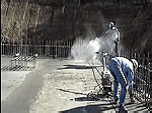Build the waterproofing in with Krystol® technology
It’s the intelligent, self-sealing water-protection system that transforms concrete into a powerful water-resistant barrier. Krystol relies on a revolutionary crystalline technology that turns porous concrete into an impermeable barrier. The result is a structure with reduced cracking, self-sealing and waterproofing abilities that provide a powerful defense against water damage and corrosion of reinforcing steel.
So whether it’s new construction, upgrading an existing structure or repairing cracks, Krystol will help you build the quality, reliability and cost-effectiveness into the concrete.
Key Benefits of the Krystol Concrete Waterproofing System
• Lower the cost of waterproofing by up to 40%
• Shave weeks off the construction schedule
• Reduce the cost of maintenance and repairs
• Increase revenues with a larger building footprint
The Krystol Advantage: Replaces unreliable exterior membrane systems
• Penetrates deep into concrete—many inches over time
• Self-seals hairline cracks—minimum .02 in. (.5mm)
• Reactivates in the presence of moisture—even years later
• Effective against hydrostatic pressure—up to 460 ft (140m) of head pressure
• Waterproof from any direction (i.e. positive or negative side)
• Impervious to physical damage and deterioration
• Certified non-toxic and safe for potable water—NSF approved
• Easy to apply and reduces potential for human error
•Works where other systems fail to eliminate leaks and water damage
How Does Integral Crystalline Waterproofing Work?

The ability to reactivate in the presence of water gives crystalline-treated concrete the ability to “self-seal”. When cracks form due to curing shrinkage, settling, seismic activity, etc., water entering through them causes new crystals to form and grow, blocking and filling the cracks. Its ability to self-seal cracks is one of crystalline technology’s most unique and useful features, and can help to dramatically reduce the long-term maintenance and repair costs of a concrete structure.
Other Benefits of Integral Crystalline Technology
Along with superior waterproofing and self-sealing properties, integral crystalline waterproofing technology offers a number of key benefits:
• Permanent solution – becomes a part of the concrete matrix so it will not crack, peel, tear or wear-away. Even against high hydrostatic pressure. Unlike externally applied membranes, which are best on the day they are applied, crystalline applications become more effective with time.
• Perfect for blind-wall applications – can be added to the concrete mix or applied to the negative side of the structure (against the water pressure). There’s no need to save room outside the structure for membrane application. Project teams can design a larger structural footprint and build right to the property line.
• Protect reinforcing steel – adds to the longevity of concrete structures by preventing the penetration of waterborne contaminants and chloride-laden liquids that cause the corrosion of reinforcing steel.
• Save weeks on construction schedules – can be applied to green concrete, or even added to the ready-mix truck. There is no need to wait for membrane application and backfilling can begin right-away.
In hot or tropical climates, integral crystalline waterproofing offers several key advantages. Hot weather can dramatically shorten concrete’s setting time, resulting in weaker concrete and enhancing the likelihood of shrinkage and cracking. Adding crystalline chemicals to the concrete mix reduces premature moisture loss, creating a more durable structure and reducing shrinkage and cracking. Unlike membrane systems that become brittle and deteriorate when exposed to prolonged heat, crystalline waterproofing is unaffected by climate and remains effective for the life of the structure.
The soil in many hot or tropical climates can contain high levels of sulphates, chlorides and other chemicals that decrease concrete’s integrity and corrode steel reinforcement. By blocking the penetration of water that can carry these contaminants and safeguarding concrete and reinforcements against corrosion, crystalline technology helps to prolong a structure’s useful life.
How is Integral Crystalline Waterproofing Applied?

Can Integral Crystalline Waterproofing Be Used in Existing Concrete Structures?

When applied to existing concrete, crystalline chemicals are absorbed into the concrete by capillary action (the natural wicking movement of liquids through a porous structure) and diffusion (the natural movement of chemical molecules.) Once inside the concrete, crystalline chemicals begin growing crystals and filling the spaces between concrete particles. The majority of active crystalline chemicals migrate into the concrete within the first 28 days, meaning the surface-applied system can be completely removed from the surface after this time without impacting its waterproofing properties.
What About Concrete Joints?
In building a concrete structure, extra care must be taken when waterproofing construction joints, since these areas are most vulnerable to cracks and leakage. Historically, the best option for waterproofing joints was to place a PVC barrier or bentonite strip into the joint before an adjoining wall was poured. However, this method is unpredictable at best because physical barriers easily become dislodged or damaged during subsequent concrete pours, rendering them ineffective and leaving joints susceptible to leakage.
Some manufacturers offer special crystalline waterstop systems that replace conventional waterstops, cost less and are easier to install. When used with the appropriate crystalline waterproofing system for new or existing concrete, crystalline waterstop systems help ensure that a structure is truly watertight. And crystalline waterstops are one of the few systems that can be retrofitted into existing joints should the original waterstop method fail or deteriorate.
Selecting a Quality Integral Crystalline Waterproofing System

Though originally received with skepticism, integral crystalline waterproofing has been repeatedly and successfully tested and used in virtually every country around the world. Over the past few decades, crystalline technology has been embraced by the construction industry as a superior replacement for conventional membranes, offering time and cost savings and flexibility that are simply unmatched by traditional waterproofing methods.



 SMART CONCRETE®
SMART CONCRETE®